Resurrection of Jesus
From Wikipedia, the free encyclopedia
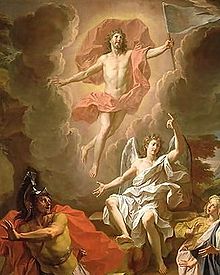
Resurrection of Christ by Noël Coypel, 1700, using a hovering depiction of Jesus
The resurrection of Jesus is the Christian religious belief that, after being put to death, Jesus rose again from the dead. It is the central tenet of Christian theology and part of the Nicene Creed: "On the third day he rose again in accordance with the Scriptures".[1]
In the New Testament, after the Romans crucified Jesus, he was anointed and buried in a new tomb by Joseph of Arimathea but God raised him from the dead[2] and he appeared to many people over a span of forty days before he ascended into heaven, to sit at the right hand of God.[3]
Paul the Apostle declared that "Christ died for our sins according to the scriptures; And that he was buried, and that he rose again the third day according to the scriptures".(1 Corinthians 15:3–4) The chapter states that such a belief in both the death and resurrection of Christ is of central importance to the Christian faith: "And if Christ has not been raised, then our preaching is in vain and your faith is in vain."(1 Cor 15:14)[4] Paul further asserted "And if Christ has not been raised, your faith is futile and you are still in your sins. Then those also who have fallen asleep in Christ have perished. If in Christ we have hope in this life only, we are of all people most to be pitied."(1 Cor 15:17–19)
Christians celebrate the resurrection of Jesus on Easter Sunday, two days after Good Friday, the day of his crucifixion. Easter's date corresponds roughly with Passover, the Jewish observance associated with the Exodus, that is fixed for the night of the Full moon near the time of the spring equinox.[5]
Part of a series on
Death and Resurrection of Jesus

Passion[show]
Hypotheses[show]
Holy Week[show]
Related[show]
Portals:
 Christianity
Christianity  Bible
Biblev
t
e
Contents [hide]
1Gospel harmony
1.1Burial
1.2Tomb discovery
1.3Post-Resurrection appearances of Jesus
2Biblical accounts
2.1Background
2.2Paul's epistles
2.3Gospel narratives
2.3.1Mark
2.3.2Matthew
2.3.3Luke
2.3.4Acts
2.3.5John
2.4Comparison of narratives in the Gospels and Acts
3Historicity and origin of the narrative
3.1As historical event
3.2As metaphor
3.3Other interpretations
10See also
11Notes
12References
13Bibliography
14External links
Gospel harmony[edit]
See also: Gospel harmony
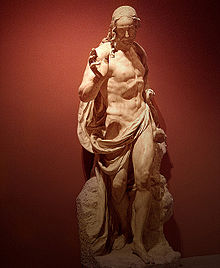
Resurrection of Jesus, Jesus Christ, part of the Resurrection group. Marble, before 1572.
In the New Testament all four gospels conclude with an extended narrative of Jesus's arrest, trial, crucifixion, burial, and his resurrection. In each gospel these five events in the life of Jesus are treated with more intense detail than any other portion of that gospel's narrative. Scholars note that the reader receives an almost hour-by-hour account of what is happening. The death and resurrection of Jesus are treated as the climax of the story, the point to which everything else has been moving all the while.[6]:p.91–92
After his death by crucifixion, Jesus was placed in a new tomb which was discovered early Sunday morning to be empty. The New Testament does not include an account of the "moment of resurrection". In the Eastern Church icons do not depict that moment, but show the myrrhbearers and depict scenes of salvation.[7][8] The major resurrection appearances of Jesus in the canonical gospels (and to a lesser extent other books of the New Testament) are reported to have occurred after his death, burial and resurrection, but prior to his ascension.[9]
Burial[edit]

Lamentation at the Tomb, 15th century.
Main article: Entombment of Christ
The synoptic gospels agree that, as the evening came after the crucifixion, Joseph of Arimathea asked Pilate for the body of Jesus, and that, after Pilate granted his request, wrapped it in linen cloth and laid it in a tomb.[10] This was in accordance with Mosaic Law, which stated that a person hanged on a tree must not be allowed to remain there at night, but should be buried before sundown.[11]
In Matthew, Joseph was identified as "also a disciple of Jesus;"[12] in Mark he was identified as "a respected member of the council (Sanhedrin) who was also himself looking for the Kingdom of God;"[13] in Luke he was identified as "a member of the council, good and righteous, who did not consent to their purpose or deed, and who was looking for the Kingdom of God'"[14] and in John he was identified as "a disciple of Jesus".[15]
The Gospel of Mark states that when Joseph of Arimathea asked for Jesus's body, Pilate marveled that Jesus was already dead, and he summoned the centurion to confirm this before releasing the body to Joseph. In the Gospel of John, it is recorded that Joseph of Arimathea was assisted in the burial process by Nicodemus, who brought a mixture of myrrh and aloes and included these spices in the burial clothes per Jewish customs.[15]
Tomb discovery[edit]
Main articles: Empty tomb and Myrrhbearers

Women at the empty tomb, by Fra Angelico, 1437–1446.
Although no single gospel gives an inclusive or definitive account of the resurrection of Jesus or his appearances, there are four points at which all four gospels converge:[16]
Attention to the stone that had closed the tomb
The linking of the empty tomb tradition and the visit of the women on "the first day of the week;"
That the risen Jesus chose first to appear to women (or a woman) and to commission them (her) to proclaim this most important fact to the disciples, including Peter and the other apostles;
The prominence of Mary Magdalene;[7][17]
Variants have to do with the precise time the women visited the tomb, the number and identity of the women; the purpose of their visit; the appearance of the messenger(s)—angelic or human; their message to the women; and the response of the women.[7]
All four gospels report that women were the ones to find the tomb of Jesus empty, although the number varies from one (Mary Magdalene) to an unspecified number. According to Mark and Luke, the announcement of Jesus' resurrection was first made to women. According to Mark and John, Jesus actually appeared first (in Mark 16:9 and John 20:14) to Mary Magdalene alone.[7]
In the gospels, especially the synoptics, women play a central role as eyewitnesses at Jesus' death, entombment, and in the discovery of the empty tomb. All three synoptics repeatedly make women the subject of verbs of seeing,[18] clearly presenting them as eyewitnesses.[19]
Post-Resurrection appearances of Jesus[edit]
Main article: Post-Resurrection appearances of Jesus
After they found the empty tomb, the gospels indicate that Jesus made a series of appearances to the disciples. He was not immediately recognizable, according to Luke.[20]:p.277 E. P. Sanders concluded that although he could appear and disappear, he was not a ghost. Writing that Luke was very insistent about that, Sanders pointed out that "the risen Lord could be touched, and he could eat".[Lk. 24:39–43] He first appeared to Mary Magdalene, but she did not recognize him at first. The first two disciples to whom he appeared, walked and talked with him for quite a while without knowing who he was, (the road to Emmaus appearance).[Lk. 24:13–32] He was made known "in the breaking of the bread".[Lk. 24:35] When he first appeared to the disciples in the upper room, Thomas was not present and wouldn't believe until a later appearance where he was invited to put his finger into the holes in Jesus' hands and side.[Jn. 20:24–29] Beside the Sea of Galilee he encouraged Peter to serve his followers. [Jn. 21:1–23] His final appearance is reported as being forty days after the resurrection when he was "carried up" into heaven[21] where he sits on the right hand of God.[Mark 16:19] [22]
At a later time, on the road to Damascus, Saul of Tarsus, then the arch-persecutor of the early disciples, was converted to Christ following an extraordinary vision and discourse with Jesus which left him blind for three days.[Acts 9:1–20] (Saul later became known as Paul the Apostle.)[Acts 13:6] [23] He became one of Christianity's foremost missionaries and theologians.[1 Cor. 15:6] [20]
While most Christians believe that Jesus' resurrection from the dead (and his subsequent ascension to Heaven) was in an actual fleshly material body, a very small minority of professed Christians believe that it was spiritual, or in a spirit body that materialized in flesh for onlookers. Some groups teach that while the resurrection was in a human body, at the ascension of Christ, he shed his human body, and is now a spirit being.[24][25][26][27]
Biblical accounts[edit]
Part of a series on
Christianity

Jesus
Christ[show]
Bible
Foundations[show]
Theology[show]
History
Tradition[show]
Related topics[show]
Denominations
Groups[show]
 Christianity portal
Christianity portalBackground[edit]
The resurrection story appears in more than five locations in the Bible. In several episodes in the Four Gospels Jesus foretells his coming death and resurrection, which he states is the plan of God the Father.[28] Christians view the resurrection of Jesus as part of the plan of salvation and redemption by atonement for man's sin.[29] Belief in a bodily resurrection of the dead became well established within some segments of Jewish society in the centuries leading up to the time of Christ, as recorded by Daniel 12:2, from the mid-2nd century BC: "Many of those sleeping in the dust shall awaken, some to everlasting life, and some to everlasting peril". Josephus (1st century AD) gives the following outline: The Pharisees believed in Resurrection of the Dead, and the Sadducees did not.[30] The Sadducees, politically powerful religious leaders, rejected the afterlife, angels, and demons as well as the Pharisees' oral law. The Pharisees, whose views became Rabbinic Judaism, eventually won (or at least survived) this debate. The promise of a future resurrection appears in the Torah as well as in certain Jewish works, such as the Life of Adam and Eve, c 100 BC, and the Pharisaic book 2 Maccabees, c 124 BC.[31]
However, 1st century Judaism had no conception of a single individual rising from the dead in the middle of history. The historical Jewish concept of resurrection was that of a redemption of the whole people.[32]Their concept was always that everybody would be raised together at the end of time. So the idea of one individual rising in the middle of history was foreign to them.[33]
Paul's epistles[edit]
The earliest written records of the death and resurrection of Jesus are the letters of Paul, which were written around two decades after the death of Jesus,[34][35] and show that within this time frame Christians believed that it had happened. Some scholars suppose that these contain early Christian creeds and creedal hymns, which were included in several of the New Testament texts and that some of these creeds date to within 50 years of Jesus' death and were developed within the Christian community in Jerusalem.[36] Though embedded within the texts of the New Testament, these creeds are a distinct source for early Christianity.
Romans 1:3–4: "...concerning his Son, who was descended from David according to the flesh and designated the Son of God in power according to the Spirit of holiness by his resurrection from the dead, Jesus Christ our Lord".[37]
2 Timothy 2:8: "Remember Jesus Christ, raised from the dead... this is my gospel for which I am suffering even to the point of being chained like a criminal. But God’s word is not chained...".[38]
1 Corinthians 15:3–7: "...that Christ died for our sins in accordance with the Scriptures, that he was buried, that he was raised on the third day in accordance with the Scriptures"
These many appearances include those to prominent members of Jesus's ministry and the later Jerusalem church, including James the brother of Jesus and the apostles, naming the apostle Peter (Cephas). The creed also makes reference to appearances to unidentified individuals. According to the Acts of the Apostles and Paul's Letter to the Galatians, he had contact with at least two of the named witnesses of the creed, James and Peter.[Gal 1:18–20] Hans Von Campenhausen and A. M. Hunter have separately stated that the creed text passes high standards of historicity and reliability of origin.[39][40]
Gospel narratives[edit]
Mark[edit]
Just before sunrise on the day after the regular weekly Sabbath three women, Mary Magdalene, Mary the mother of James, and Salome, come to anoint Jesus' body, wondering how they would be able to roll the large rock away from the tomb; but they found the rock already rolled aside and a young man in white inside; he told them that Jesus had risen, and that they should tell Peter and the disciples that he will meet them in Galilee, "just as he told you". Then the women ran away and told no-one.[Mark 16]
Matthew[edit]
Just before sunrise on the day after the regular weekly Sabbath two women, Mary Magdalene and "the other Mary", went to look at the tomb. Accompanied by an earthquake, an angel had come down from Heaven and rolled the rock aside from the tomb. The angel waited for them and told them not to be afraid, but to tell the disciples that Jesus had risen and will meet them in Galilee. The women were joyful and set out to tell the disciples the good news, then soon afterward Jesus appeared and told them not to be afraid, and told them that He had risen and that they should tell the disciples that they will see Him in Galilee. The disciples go to Galilee, where they then see Jesus in the flesh.
The soldiers guarding the tomb were terrified by the angel, and informed the chief priests; the priests and elders bribed them to spread a lie that the disciples stole the body, "[a]nd this story has been widely circulated among the Jews to this very day".[Matthew 27:61–28:3]
Luke[edit]
Just after sunrise on the day after the Sabbath a number of women (Mary Magdalene, Joanna, and Mary the mother of James) come to anoint Jesus's body. They find the stone rolled away and the tomb empty. Suddenly two men stand beside them. The men tell them Jesus is risen. The women tell the disciples, but the disciples do not believe them, except for Peter who runs to the tomb. Peter finds the grave-clothes in the empty tomb and goes away, wondering.
The same day Jesus appears to two of his followers on the road to Emmaus. They fail to recognise him until he breaks bread and gives thanks, and he then vanishes. The two go at once to Jerusalem where they find the disciples exclaiming over Jesus' appearance to Peter. As they tell their story Jesus appears to them all. They are afraid, but he invites them to touch his body, eats with them, and explains the prophecies which are fulfilled in him.[Luke 24]
Acts[edit]
(The Acts of the Apostles is presented as a continuation of the Gospel of Luke.) Jesus appeared to the apostles for forty days, giving many proofs that he was alive, and instructing them not to leave Jerusalem until they were baptised with the Holy Spirit.[Acts 1]
John[edit]
Early on the day after the Sabbath, before sunrise, Mary Magdalene visited the tomb and found the large stone had already been rolled away. She told Peter and "the beloved disciple", who then ran to the tomb to only find empty the grave-clothes, then go home. They assume his body had been stolen. Mary wept, then sees two angels that speak to her, and then Jesus, whom she does not recognise. Jesus told her to tell the disciples that he is ascending to the Father, and Mary then tells the disciples she had seen the Lord.
That evening Jesus appeared among them, despite having locked the doors, and gives them power over sin and forgiveness of sin. A week later he appears to doubting Thomas, who has not believed, but when Thomas is instructed to touch the wounds of Jesus he says, "My Lord and my God!" Jesus replies: "Because you have seen me, you have believed; blessed are those who have not seen and yet have believed".[John 20]
Comparison of narratives in the Gospels and Acts[edit]
MatthewMarkLukeJohnActs
Empty tomb [28:1–7] Empty tomb [16:1–7] Empty tomb [24:1–7] Empty tomb [20:1–10]
Jesus appeared to Mary Magdalene and the other Mary [28:9–10] Jesus appeared to Mary Magdalene [16:9] Jesus appeared to Mary Magdalene[20:11–18]
Jesus appeared to two disciples [16:12] Jesus appeared to two disciples [24:13–31] Jesus appeared to apostles for forty days [1:3]
Jesus appeared to eleven disciples [28:16–20] Jesus appeared to eleven disciples [16:14–18] Jesus appeared to disciples [24:36–50] Jesus appeared to disciples;[20:19–31]Jesus appeared again to disciples[21:1–22]
Jesus promises the Holy Spirit[1:4–8]
Jesus was taken up into heaven [16:19] Jesus was taken up into heaven [24:51] Jesus was taken up into heaven[1:9-11]
Historicity and origin of the narrative[edit]
Main article: Historicity and origin of the Resurrection of Jesus
5 part resurrection icon, Solovetsky Monastery, 17th century.
As historical event[edit]
New Testament scholar and theologian E. P. Sanders argues that a concerted plot to foster belief in the Resurrection would probably have resulted in a more consistent story, and that some of those who were involved in the events gave their lives for their belief. Sanders offers his own hypothesis, saying "there seems to have been a competition: 'I saw him,' 'so did I,' 'the women saw him first,' 'no, I did; they didn't see him at all,' and so on."[41] In defending the historicity of the resurrection, Sanders goes so far as to state, "That Jesus’ followers (and later Paul) had resurrection experiences is, in my judgment, a fact. What the reality was that gave rise to the experiences I do not know."[42]
James D.G. Dunn writes that, whereas the apostle Paul's resurrection experience was "visionary in character" and "non-physical, non-material," the accounts in the Gospels are very different. He contends that the "massive realism'...of the [Gospel] appearances themselves can only be described as visionary with great difficulty – and Luke would certainly reject the description as inappropriate," and that the earliest conception of resurrection in the Jerusalem Christian community was physical.[43] Conversely, Helmut Koester writes that the stories of the resurrection were originally epiphanies in which the disciples are called to a ministry by the risen Jesus and were interpreted as physical proof of the event at a secondary stage. He contends that the more detailed accounts of the resurrection are also secondary and do not come from historically trustworthy sources, but instead belong to the genre of the narrative types.[44]
N.T. Wright argues that the account of the empty tomb and the visionary experiences point towards the historical reality of the resurrection.[45]He suggests that multiple lines of evidence from the New Testament and the early Christian beliefs it reflects shows that it would be highly unlikely that belief in the empty tomb would simply appear without a clear basis in the memory of early Christians. In tandem with the historically certain visionary experiences of the early disciples and apostles, Jesus' resurrection as a historical reality becomes far more plausible. Wright treats the resurrection as a historical and accessible event, rather than as a 'supernatural' or 'metaphysical' event.
Summarizing its traditional analysis, the Catholic Church stated in its Catechism: "Although the Resurrection was an historical event that could be verified by the sign of the empty tomb and by the reality of the apostles' encounters with the risen Christ, still it remains at the very heart of the mystery of faith as something that transcends and surpasses history."[46]
As metaphor[edit]
In his book The First Coming: How the Kingdom of God Became Christianity, Thomas Sheehan argues that even Paul's account of the resurrection is not meant to be taken as referring to a literal, physical rising from the grave, and that stories of a bodily resurrection did not appear until as much as half a century following the crucifixion.[47]Instead, Sheehan believes that Paul's understanding of the resurrection, and perhaps Peter's as well, is a metaphysical one, with the stories of Jesus's (figurative) resurrection reflecting his triumphant "entry into God's eschatological presence,"[48] and that Paul's reference to Jesus having risen "on the third day" (1 Corinthians 15:4) "is not a chronological designation but an apocalyptic symbol for God's eschatological saving act, which strictly speaking has no date in history. Thus the 'third day' does not refer to Sunday, April 9, 30 C.E., or to any other moment in time. And as regards the 'place' where the resurrection occurred, the formula in First Corinthians does not assert that Jesus was raised from the tomb, as if the raising were a physical and therefore temporal resuscitation. Without being committed to any preternatural physics of resurrection, the phrase 'he was raised on the third day' simply expresses the belief that Jesus was rescued from the fate of utter absence from God (death) and was admitted to the saving presence of God (the eschatological future)."[49]
Other interpretations[edit]
Peter Kirby, the founder of EarlyChristianWritings.com, states that, "Many scholars doubt the historicity of the empty tomb."[50][a] According to Robert M. Price, Christian "apologists love to make the claims ... that the resurrection of Jesus is the best attested event in history", but "probabilistic arguments" show that "the resurrection is anything but an open-and-shut case".[51] Robert Greg Cavin, a professor of Philosophy and Religious Studies at Cypress College, states that, "our only sources of potential evidence, the New Testament Easter traditions, fall far short of providing the kind of information necessary for establishing the resurrection hypothesis."[52][b]
Biblical scholar Géza Vermes analyzes this subject in his book, The Resurrection. He concludes that there are eight possible theories to explain the "resurrection of Jesus". Vermes outlines his boundaries as follows,
I have discounted the two extremes that are not susceptible to rational judgment, the blind faith of the fundamentalist believer and the out-of-hand rejection of the inveterate skeptic. The fundamentalists accept the story, not as written down in the New Testament texts, but as reshaped, transmitted, and interpreted by Church tradition. They smooth down the rough edges and abstain from asking tiresome questions. The unbelievers, in turn, treat the whole Resurrection story as the figment of early Christian imagination. Most inquirers with a smattering of knowledge of the history of religions will find themselves between these two poles.[53]
From his analysis, Vermes presents the remaining six possibilities to explain the resurrection of Jesus account, (1) "The body was removed by someone unconnected with Jesus", (2) "The body of Jesus was stolen by his disciples", (3) "The empty tomb was not the tomb of Jesus", (4) Buried alive, Jesus later left the tomb", (5) Jesus recovered from a coma and departed Judea, and (6) the possibility that there was a "spiritual, not bodily, resurrection". Vermes states that none of these six possibilities are likely to be historical.[54]
According to N. T. Wright in his book The Resurrection of the Son of God, "There can be no question: Paul is a firm believer in bodily resurrection. He stands with his fellow Jews against the massed ranks of pagans; with his fellow Pharisees against other Jews."[55] And according to Gary Habermas, "Many other scholars have spoken in support of a bodily notion of Jesus’ resurrection."[56]
Habermas also argues three facts in support of Paul's belief in a physical resurrection body. (1) Paul is a Pharisee and therefore (unlike the Sadducees) believes in a physical resurrection. (2) In Philippians 3:11 Paul says "That I may attain to the ek anastasis (out-resurrection)" from the dead, which according to Habermas means that "What goes down is what comes up". And (3) In Philippians 3:20–21 "We look from heaven for Jesus who will change our vile soma (body) to be like unto his soma (body)". According to Habermas, if Paul meant that we would change into a spiritual body then Paul would have used the Greek pneuma instead of soma.[57] Although others argue that a "body" (or "soma") can be a spirit "body", not necessarily "flesh", in order for it to be a body, according to Paul's own words to the Corinthians, regarding "spiritual body". But they say that it was a true resurrection nonetheless.[24]
Flavius Josephus (c. 37–c. 100), a Jew and Roman citizen who worked under the patronage of the Emperor Vespasian and his son Titus, wrote the Antiquities of the Jews c. 93 which contains a passage known as the Testimonium Flavianum. This passage mentions John the Baptist and Jesus as two holy men among the Jews.[58] Most modern scholars believe the original text of the work has been changed by Christian editors. The text mentions the death and resurrection of Jesus: "When Pilate, upon the accusation of the first men amongst us, condemned [Jesus] to be crucified, those who had formerly loved him did not cease [to follow him], for he appeared to them on the third day, living again, as the divine prophets foretold, along with a myriad of other marvellous things concerning him."[59]
There are various other arguments against the historicity of the resurrection story. For example, the number of other historical figures and gods with similar death and resurrection accounts has been pointed out.[60][c] However the majority consensus among biblical scholars is that the genre of the Gospels is a kind of ancient biography and not myth.[61] Robert M. Price claims that if the resurrection could, in fact, be proven through science or historical evidence, the event would lose its miraculous qualities.[60] In a more focused argument, Carrier asserts that, "The surviving evidence legal and historical, suggests that Jesus was not formally buried Friday night," but that "it had to have been placed Saturday night in a special public graveyard reserved for convicts. On this theory, the women who visited the tomb Sunday morning mistook its vacancy."[62]
New Testament historian Bart D. Ehrman recognizes that "Some scholars have argued that it's more plausible that in fact Jesus was placed in a common burial plot, which sometimes happened, or was, as many other crucified people, simply left to be eaten by scavenging animals." He further elaborates by saying: "[T]he accounts are fairly unanimous in saying (the earliest accounts we have are unanimous in saying) that Jesus was in fact buried by this fellow, Joseph of Arimathea, and so it's relatively reliable that that's what happened."[63]
Extra-biblical accounts[edit]

Depiction by Raphael, 1449–1502
The Gospel of Peter[edit]
The Gospel of Peter is attributed to Apostle Peter that describes the trial and resurrection of Jesus.
The Book of Mormon[edit]
The Book of Mormon contains a 37-page account of Christ's ministry after his resurrection, in which he appears to the Nephites and Lamanites in the Americas after rising from the tomb and ascending into heaven. He appears to the people and lets them feel the prints of the nails in his hands and feet.[64] He then preaches the gospel to them and establishes his church. Christ performs many miracles similar to those of the New Testament.
The account claims that about 2500 men, women, and children saw and heard the resurrected Jesus Christ.[65]
Other appearances[edit]
Joseph Smith recorded an experience in which the resurrected Jesus Christ and God the Father appeared to him in the spring of 1820; his experience is known today as the First Vision.[66]
In 1832, Joseph Smith and Sidney Rigdon wrote an account in which they both claimed to have seen the resurrected Jesus Christ. They wrote, "And now, after the many testimonies which have been given of him, this is the testimony last of all, which we give of him, that he lives; for we saw him, even on the right hand of God, and we heard the voice bearing record that he is the Only Begotten of the Father."[67][68]
Theological significance[edit]
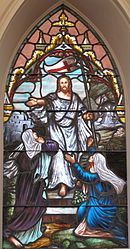
Stained glass of Resurrection with two Marys at a Lutheran Church, South Carolina.
In Christian theology, the resurrection of Jesus is a foundation of the Christian faith.[1 Cor 15:12–20][1 Pet 1:3] Christians, through faith in the working of God[Col 2:12] are spiritually resurrected with Jesus, and are redeemed so that they may walk in a new way of life.[Rom 6:4] As Paul the Apostle stated: "If Christ was not raised, then all our preaching is useless, and your trust in God is useless".[1 Cor 15:14] The death and resurrection of Jesus are the most important events in Christian Theology. They form the point in scripture where Jesus gives his ultimate demonstration that he has power over life and death, thus he has the ability to give people eternal life.[69] Terry Miethe, a Christian philosopher at Oxford University, stated, " 'Did Jesus rise from the dead?' is the most important question regarding the claims of the Christian faith.' "[70] According to the Bible, "God raised him from the dead",[71] he ascended to heaven, to the "right hand of God",[72] and will return again[Acts 1:9–11] to fulfill the rest of Messianic prophecy such as the Resurrection of the dead, the Last Judgment and establishment of the Kingdom of God; see also Messianism and Messianic Age.[73]
Some modern scholars use the belief of Jesus' followers in the resurrection as a point of departure for establishing the continuity of the historical Jesus and the proclamation of the early church.[74] Carl Jung suggests that the crucifixion-resurrection account was the forceful spiritual symbol of, literally, God-as-Yahweh becoming God-as-Job.[75]
The apostle Paul wrote that: "If there is no resurrection of the dead, then Christ has not been raised; if Christ has not been raised, then our preaching is in vain and your faith is in vain... If Christ has not been raised, your faith is futile".[1 Cor 15:13–14, 17] [76] Many scholars have contended that in discussion on the resurrection, the apostle Paul refers to a rabbinic style transmission of an early authoritative tradition that he received and has passed on to the church at Corinth. For this and other reasons, it is widely believed that this creed is of pre-Pauline origin.[77][78] Geza Vermes writes that the creed is "a tradition he [Paul] has inherited from his seniors in the faith concerning the death, burial and resurrection of Jesus".[79] The creed's ultimate origins are within the Jerusalem apostolic community having been formalised and passed on within a few years of the resurrection.[80] Paul Barnett writes that this creedal formula, and others, were variants of the "one basic early tradition that Paul "received" in Damascus from Ananias in about 34 [AD]" after his conversion.[81]
But Christ really has been raised from the dead. He is the first of all those who will rise. Death came because of what a man did. Rising from the dead also comes because of what a man did. Because of Adam, all people die. So because of Christ, all will be made alive.[82]
Paul's views went against the thoughts of the Greek philosophers to whom a bodily resurrection meant a new imprisonment in a corporeal body, which was what they wanted to avoid—given that for them the corporeal and the material fettered the spirit.[83] At the same time, Paul believed that the newly resurrected body would be a heavenly body; immortal, glorified, powerful and spiritual in contrast to an earthly body, which is mortal, dishonored, weak and natural.[84] According to theologian Peter Carnley, the resurrection of Jesus was different from the Resurrection of Lazarus as: "In the case of Lazarus, the stone was rolled away so that he could walk out... the raised Christ didn't have to have the stone rolled away, because he is transformed and can appear anywhere, at any time".[85]
According to international scholar Thorwald Lorenzen, the first Easter led to a shift in emphasis from faith "in God" to faith "in Christ". Today, Lorenzen finds "a strange silence about the resurrection in many pulpits". He writes that among some Christians, ministers and professors, it seems to have become "a cause for embarrassment or the topic of apologetics".[86]:pp.3–4 It has been argued that many Christians neglect the resurrection because of their understandable preoccupation with the Cross.[87] However, the belief in Jesus' physical resurrection remains the single doctrine most accepted by Christians of all denominational backgrounds.
Resurrection and redemption[edit]
Emperor Constantine and bishops with the Creed of 381.
In the teachings of the apostolic Church, the resurrection was seen as heralding a new era. Forming a theology of the resurrection fell to the apostle Paul. It was not enough for Paul to simply repeat elementary teachings, but as Hebrews 6:1 states, "go beyond the initial teachings about Christ and advance to maturity". Fundamental to Pauline theology is the connection between Christ's Resurrection and redemption.[88] Paul explained the importance of the resurrection of Jesus as the cause and basis of the hope of Christians to share a similar experience.[89]
The teachings of the apostle Paul formed a key element of the Christian tradition and theology. If His death stands at the center of Paul's theology, so does the Resurrection: unless the one died the death of all, the all would have little to celebrate in the resurrection of the one.[90]Paul taught that, just as Christians share in Jesus' death in baptism, so they will share in his resurrection[91] for Jesus was designated the Son of God by his resurrection.[Rom 1:4][91] In 1 Corinthians 15:20–22 Paul states:
But Christ really has been raised from the dead. He is the first of all those who will rise. Death came because of what a man did. Rising from the dead also comes because of what a man did. Because of Adam, all people die. So because of Christ, all will be made alive.
The Apostolic Fathers, discussed the death and resurrection of Jesus, including Ignatius (50–115),[92] Polycarp (69–155), and Justin Martyr (100–165). Following the conversion of Constantine and the liberating Edict of Milan in 313, the ecumenical councils of the 4th, 5th and 6th centuries, that focused on Christology helped shape the Christian understanding of the redemptive nature of Resurrection, and influenced both the development of its iconography, and its use within Liturgy.[93]
Belief in bodily resurrection was a constant note of the Christian church in antiquity. And nowhere was it argued for more strongly than in North Africa. Saint Augustine accepted it at the time of his conversion in 386.[94] Augustine defended Resurrection, and argued that given that Christ has risen, there is Resurrection of the Dead.[95][96] Moreover, he argued that the death and resurrection of Jesus was for the salvation of man, stating: "to achieve each resurrection of ours, the savior paid with his single life, and he pre-enacted and presented his one and only one by way of sacrament and by way of model."[97]
The 5th century theology of Theodore of Mopsuestia provides an insight into the development of the Christian understanding of the redemptive nature of Resurrection. The crucial role of the sacraments in the mediation of salvation was well accepted at the time. In Theodore's representation of the Eucharist, the sacrificial and salvific elements are combined in the "One who saved us and delivered us by the sacrifice of Himself". Theodore's interpretation of the Eucharistic rite is directed towards the triumph over the power of death brought about by the Resurrection.[98]
The emphasis on the salvific nature of the Resurrection continued in Christian theology in the next centuries, e.g., in the 8th century Saint John of Damascus wrote that: "... When he had freed those who were bound from the beginning of time, Christ returned again from among the dead, having opened for us the way to resurrection" and Christian iconography of the ensuing years represented that concept.[99]
Relics[edit]
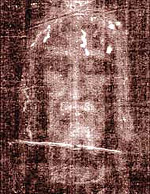
Secondo Pia's 1898 negative of the image on the Shroud of Turin has an appearance suggesting a positive image. It is used as part of the devotion to the Holy Face of Jesus.
Main articles: Acheiropoieta, Shroud of Turin, and Veil of Veronica
The resurrection of Jesus has long been central to Christian faith and appears within diverse elements of the Christian tradition, from feasts to artistic depictions to religious relics. In Christian teachings, the sacraments derive their saving power from the passion and resurrection of Christ, upon which the salvation of the world entirely depends.[100]
An example of the interweaving of the teachings on the resurrection with Christian relics is the application of the concept of "miraculous image formation" at the moment of resurrection to the Shroud of Turin. Christian authors have stated the belief that the body around whom the shroud was wrapped was not merely human, but divine, and that the image on the shroud was miraculously produced at the moment of resurrection.[101][102] Quoting Pope Paul VI's statement that the shroud is "the wonderful document of His Passion, Death and Resurrection, written for us in letters of blood" author Antonio Cassanelli argues that the shroud is a deliberate divine record of the five stages of the Passion of Christ, created at the moment of resurrection.[103]
Easter[edit]
Main article: Easter
Easter, the preeminent feast that celebrates the resurrection of Jesus, is clearly the earliest Christian festival.[104] Since the earliest Christian times, it has focused on the redemptive act of God in the death and resurrection of Christ.[105]
Easter is linked to the Passover and Exodus from Egypt recorded in the Old Testament through the Last Supper and crucifixion that preceded the resurrection. According to the New Testament, Jesus gave the Passover meal a new meaning, as he prepared himself and his disciples for his death in the upper room during the Last Supper. He identified the loaf of bread and cup of wine as his body soon to be sacrificed and his blood soon to be shed. 1 Corinthians states, "Get rid of the old yeast that you may be a new batch without yeast—as you really are. For Christ, our Passover lamb, has been sacrificed"; this refers to the Passover requirement to have no yeast in the house and to the allegory of Jesus as the Paschal lamb.[106]
Views of other religions[edit]
Groups such as Jews, Muslims, Bahá'ís, and other non-Christians, as well as some liberal Christians, dispute whether Jesus actually rose from the dead. Arguments over death and resurrection claims occur at many religious debates and interfaith dialogues.[86]
Gnostics[edit]
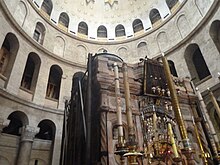
A rotunda in Church of the Holy Sepulchre, called the Anastasis ("Resurrection"), which contains the remains of a rock-cut room that Helena and Macarius identified as the burial site of Jesus.
Some Gnostics did not believe in a literal physical resurrection. "For the gnostic any resurrection of the dead was excluded from the outset; the flesh or substance is destined to perish. 'There is no resurrection of the flesh, but only of the soul', say the so-called Archontics, a late gnostic group in Palestine".[107]
Judaism[edit]
Main article: Judaism's view of Jesus
Christianity split with Judaism in the 1st century AD, and the two faiths have differed in their theology since. According to the Toledot Yeshu, the body of Jesus was removed in the same night by a gardener named Juda, after hearing the disciples planned to steal the body of Jesus.[108][109]However, Toledot Yeshu is not considered either canonical or normative within rabbinic literature.[110] Van Voorst states that Toledot Yeshu is a medieval document set without a fixed form which is "most unlikely" to have reliable information about Jesus.[111] The Blackwell Companion to Jesus states that the Toledot Yeshu has no historical facts as such, and was perhaps created as a tool for warding off conversions to Christianity.[112]
Islam[edit]
Main article: Islamic view of Jesus' death
Muslims believe that ʿĪsā (Jesus) son of Mariam (Mary) was a holy prophet with a divine message. The Islamic perspective is that Jesus was not crucified and will return to the world at the end of times. "But Allāh raised him up to Himself. And Allāh is Ever All-Powerful, All-Wise".[113]The Quran says in Surah An-Nisa [Ch004:Verse157] "And because of their saying, "We killed Messiah ʿĪsā, son of Mariam, the Messenger of Allāh", – but they killed him not, nor crucified him, but it appeared so to them, and those who differ therein are full of doubts".[114]
Baha'i Faith[edit]
`Abdu'l-Bahá taught that Christ's resurrection was a spiritual resurrection and that the accounts in the Gospels are parables. `Abdu'l-Bahá wrote: "We explain, therefore, the meaning of Christ's resurrection in the following way: After the martyrdom of Christ the Apostles were perplexed and dismayed. The reality of Christ, which consists in His teachings, His bounties, His perfections and His spiritual power, was hidden and concealed for two or three days after His martyrdom, and had no outward appearance or manifestation — indeed, it was as though it were entirely lost. For those who truly believed were few in number and even those few were perplexed and dismayed. The Cause of Christ was thus as a lifeless body. After three days the Apostles became firm and steadfast, arose to aid the Cause of Christ, resolved to promote the divine teachings and practice their Lord's admonitions, and endeavoured to serve Him. Then did the reality of Christ become resplendent, His grace shine forth, His religion find new life, and His teachings and admonitions become manifest and visible. In other words the Cause of Christ, which was like unto a lifeless body, was quickened to life and surrounded by the grace of the Holy Spirit." [115]
Baha'is believe the Qur'an's statement: "And because of their saying, "We killed Messiah ʿĪsā, son of Mariam, the Messenger of Allāh", – but they killed him not, nor crucified him, but it appeared so to them, and those who differ therein are full of doubts".[114] means that Jesus's Spirit didn't die on the cross, however Baha'is uphold that Jesus was actually crucified in the flesh.
In Christian art[edit]
Main article: Resurrection of Jesus in Christian art

The Chi Rho with a wreath symbolizing the victory of the Resurrection, above Roman soldiers, c. 350.
In the Catacombs of Rome, artists just hinted at the Resurrection by using images from the Old Testament such as the fiery furnace and Daniel in the Lion's den. Depictions prior to the 7th century generally showed secondary events such as the Myrrhbearers at the tomb of Jesus to convey the concept of the Resurrection. An early symbol of the resurrection was the wreathed Chi Rho, whose origin traces to the victory of emperor Constantine I at the Battle of the Milvian Bridge in 312, which he attributed to the use of a cross on the shields of his soldiers. Constantine used the Chi Rho on his standard and his coins showed a labarum with the Chi Rho killing a serpent.[116]
The use of a wreath around the Chi Rho symbolizes the victory of the Resurrection over death, and is an early visual representations of the connection between the Crucifixion of Jesus and his triumphal resurrection, as seen in the 4th century sarcophagus of Domitilla.[117] in Rome. Here, in the wreathed Chi Rho the death and resurrection of Christ are shown as inseparable, and the Resurrection is not merely a happy ending tucked at the end of the life of Christ on earth. Given the use of similar symbols on the Roman standard, this depiction also conveyed another victory, namely that of the Christian faith: the Roman soldiers who had once arrested Jesus and marched him to Calvary now walked under the banner of a resurrected Christ.[118]
The cosmic significance of the Resurrection in Western theology goes back to Saint Ambrose who in the 4th century said that "The universe rose again in Him, the heaven rose again in Him, the earth rose again in Him, for there shall be a new heaven and a new earth".[119][120] This theme developed gradually in the West, and later than in the East, where the Resurrection was early linked to redemption and the renewal and rebirth of the whole world. In art this was symbolized by combining the depictions of the Resurrection with the Harrowing of Hell in icons and paintings. A good example is from the Chora Church in Istanbul, where John the Baptist, Solomon and other figures are also present, depicting that Christ was not alone in the resurrection.[120] The depiction sequence at the 10th century Hosios Loukas shows Christ as he pulls Adam, followed by Eve from his tomb, signifying the salvation of humanity after the resurrection.[121]
Gallery of art[edit]For a larger gallery, please see: Resurrection gallery

Resurrection of Christ by Hans Rottenhammer

Resurrection of Christ by Hans Memling

Resurrection by Luca Giordano
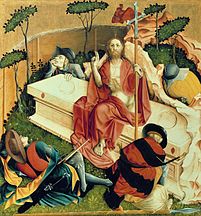
Resurrection by Hans Multscher
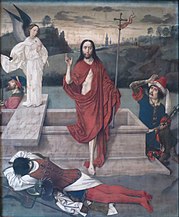
Resurrection by Dieric Bouts

Resurrection by Marco Basaiti

Piero della Francesca, 15th century

The Resurrection of Christ, Alonso López de Herrera

The Resurrection (La Résurrection) - James Tissot, c.1890, Brooklyn Museum
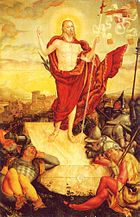
Lucas Cranach, 1558
See also[edit]
Chronology of Jesus
Divine Mercy Sunday
Dying god
Easter
Tomb of Jesus:
The Church of the Holy Sepulchre, the ground on which the church stands is venerated by most Christians as Golgotha, the Hill of Calvary, where the New Testament says that Jesus was crucified. This tomb is venerated as the tomb of Christ by the Catholic Church, Eastern Orthodox churches, and Oriental Orthodox churches.
The Garden Tomb, discovered in the 19th century, considered the actual site of Jesus' grave by some Protestant Christians.
Talpiot Tomb, discovered in 1980, subject of the controversial documentary The Lost Tomb of Jesus
The Resurrection of Jesus Christ
Notes[edit]
a.^ In a note, Kirby states, "A very abbreviated list of twentieth-century writers on the NT who do not believe that the empty tomb is historically reliable: Marcus Borg, Günther Bornkamm, Gerald Boldock Bostock, Rudolf Bultmann, Peter Carnley, John Dominic Crossan, Stevan Davies, Maurice Goguel, Michael Goulder, Hans Grass, Charles Guignebert, Uta Ranke-Heinemann, Randel Helms, Herman Hendrikx, Roy Hoover, Helmut Koester, Hans Küng, Alfred Loisy, Burton L. Mack, Willi Marxsen, Gerd Lüdemann, Norman Perrin, Robert M. Price, Marianne Sawicki, John Shelby Spong, Howard M. Teeple, and John T. Theodore".[122]b.^ Cavin continues "... even on the assumption of their complete historical reliability ... This assumption, of course, is rightly dismissed in light of contemporary New Testament scholarship".c.^ Robert M. Price points to the accounts of Adonis, Appollonius of Tyana, Asclepius, Attis, Empedocles, Hercules, Osiris, Oedipus, Romulus, Tammuz, and others.[123]
